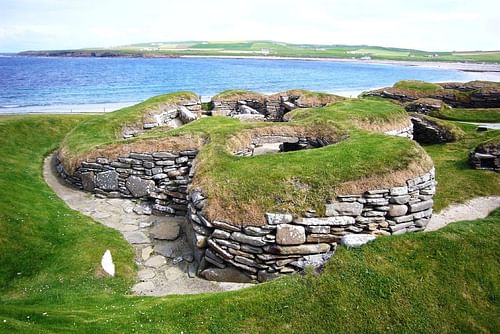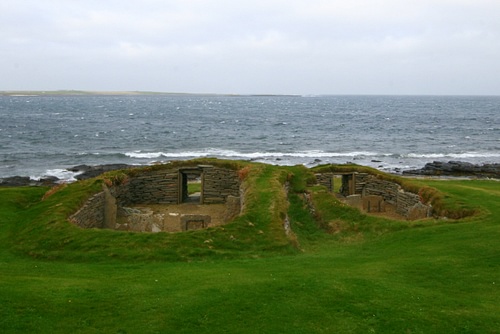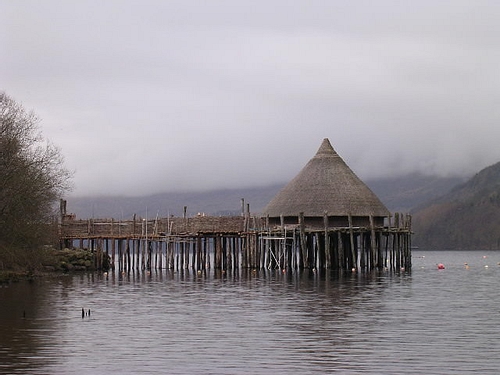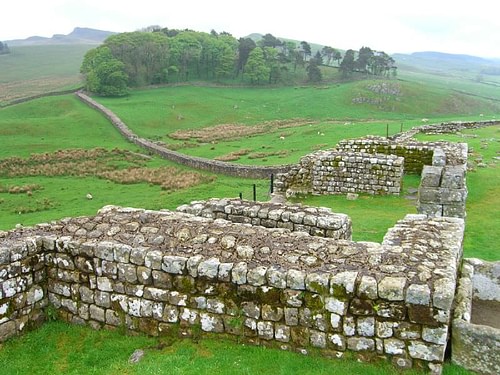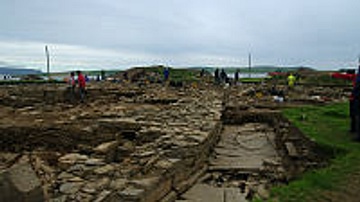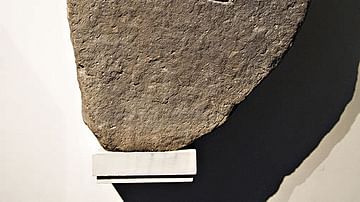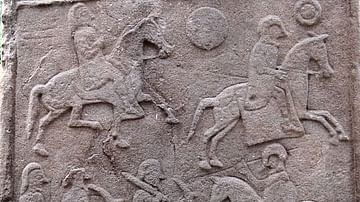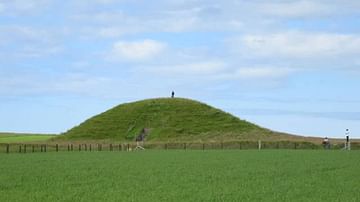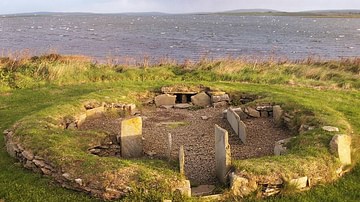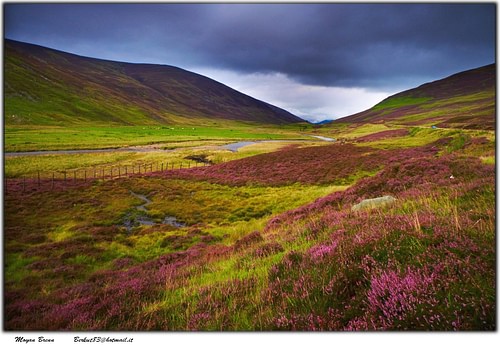
Scotland is a country which, today, comprises the northern part of Great Britain and includes the islands known as the Hebrides and the Orkneys. The name derives from the Roman word "Scotti" which designated an Irish tribe who invaded the region and established the kingdom of Dal Riata. A claim has also been made, however, that the land is named after Scota, daughter of an Egyptian Pharaoh, who married the Celt Erimon son of Mil and settled in the land which came to be known as Scotland.
Prior to this, the land north of Hadrian's Wall was known by the Romans as Caledonia and, in Scots Gaelic, as Alba. The precise meaning of these names and their etymology remains a subject of debate, though "rocky land" has been offered as a likely candidate for Caledonia and "white" is the direct translation of Alba. While it is clear that "Alba" once referred to the whole of Great Britain, the theory that it referenced the white cliffs of Dover is disputed. The early Scots referred to the kingdom of the Picts as "Alba" and said kingdom, in the north of Scotland, was, of course, nowhere near Dover of Britain.
Early Human Habitation
The history of ancient Scotland is told through the standing stones, ancient settlements, and burial places built by those who lived in the region. No written history of the people who came to be known as the Scots exists prior to the coming of the Romans in 79/80 CE. By that time, the land had been inhabited for thousands of years. In the 1960's CE, the archaeologist John Mercer established that the stone rings found at Lussa Wood and the Mesolithic settlement, An Carn, both on the Isle of Jura in the Inner Hebrides, are the oldest stone structures in Scotland, dating back to 7000 BCE with seasonal settlement of the area going back at least to 10,500 BCE.
Even so, there are ancient sites on the island of Rum, further north, which have been dated to 7700 BCE, and the famous site at Crammond, near Edinburgh, dates to 8400 BCE. There is further evidence of Mesolithic settlements (some seasonal) found on nearby Oronsay, at Kintyre, Luce Bay and further on in Fife, and the Paleolithic site at Howburn Farm in Biggar, though certainly a seasonal camp, dates to 12,000 BCE.
The Howburn Farm site is the oldest evidence of human habitation from the Late Upper Paleolithic Age. Archaeological evidence suggests that the deep forests of the region seemed inhospitable to the early settlers at first. It seems, from evidence found in middens (ancient garbage dumps), that they subsisted on fishing early on but then ventured further from the shores to hunt game. Evidence of their hunting activities comes from bone and antler remains found at sites such as Jura and Oronsay. The Howburn Farm site indicates a seasonal hunting camp, which was repeatedly visited by large parties but never developed into a permanent community.
Mesolithic sites stretch from Orkney in the north down to the Inner Hebrides. By 6000 BCE the inhabitants were using bones and antlers as tools. The ring and cup marks engraved in stones at the An Carn site, and others, give evidence they were made with such implements. Flint was also in use at this time. It is generally understood that the Mesolithic people were nomadic hunters and fishermen as no evidence of permanent settlements has been discovered, while there is much to suggest the nomadic lifestyle such as middens near areas which were cleared for campsites.
The Neolithic Age
The Neolithic inhabitants made more permanent settlements and, among these, is the famous site of the stone village of Skara Brae (c. 3100 BCE) and the larger complex known as the Ness of Brodgar (c. 3500 BCE). First discovered in 1850 CE, after a storm swept away the sand covering the structures, Skara Brae was considered the most impressive Neolithic Age site until excavations began on the Ness of Brodgar in 2003 CE which presently covers 6.2 acres (2.5 hectares), and is still undergoing excavation.
Beginning in about 4000 BCE, the Neolithic people, following the example of the earlier Paleolithic inhabitants, built their homes and laid out their farms by the shore. Even so, the present location near the sea of sites such as Skara Brae should not be interpreted to mean all such villages were originally built by the shore, as land erosion must be taken into account and geological, as well as archaeological, evidence suggests these sites were much further inland than they are today.
It has been suggested that the Neolithic people came to Scotland from the sea, most likely from Scandinavia. The Knap of Howar site, on the island of Papa Westray, Orkney, was occupied between 3700-2800 BCE and is considered the oldest stone house in northern Europe. Its remote location on the shore of the island has long supported the claim of Neolithic people arriving from the sea to settle on the shore but, as with other such sites, the farmstead at Knap of Howar was originally further inland. It is almost certain that early inhabitants of Orkney came from Scandinavia based upon place names and archaeological evidence.
These people built their communities out of whatever material was close at hand and so, in the north, one finds stone constructions such as the Ness of Brodgar and Skara Brae while, toward the south, where timber was more plentiful, the buildings were constructed of wood (such as the Balbridie Timber Hall of Aberdeenshire). The one aspect of their settlements which remained consistent throughout the land was the construction of burial sites from stone. Cairns, barrows, passage graves, chambered tombs and burial mounds, all built by the dry stone method (placing and lodging one stone snugly against another without mortar) have been discovered throughout Scotland.
The use of stone in building burial places seems to have honed a skill in such work which culminated in the construction of sites such as the Ring of Brodgar and the Standing Stones of Stenness, both in Orkney and located in proximity to the Ness of Brodgar, where giant monoliths were raised. The sites suggest a ritual use and an astronomical alignment is clear but what the rituals consisted of remains a mystery. The construction of such sites has led some scholars to label this period (3100-2500 BCE) Megalithic to differentiate from the earlier Neolithic period.
The sites consist of a large, circular ditch surrounding the standing monoliths with an outer circle of timber posts which may possibly have supported a roof or may simply have been a means of separating a kind of "clergy" class, who performed the rites, from the general populace gathered outside. All such theories are based upon post-holes at regular intervals found at the sites and organic material dated to the same period as the raising of the stones. Single monoliths bearing the ring and cup marks have been found throughout Scotland and are especially plentiful in the Aberdeenshire region.
The Bronze Age
Around the year 2500 BCE immigrants known as the Beaker People began to arrive on the east coast of Scotland. "Beaker People" is a modern label given to those who developed the production of earthenware pottery, most notably beakers for drinking mead. Prior to 2500 BCE there is no evidence of earthenware pottery in use in this particular way. Further, the Beaker People widely practised the custom of burying their dead with food, drink, and other items which would be necessary in the afterlife – a custom which the Neolithic people did not observe – further substantiating the theory of a mass migration from Europe rather than an indigenous development in ceramic arts.
The next migratory influence produced the so-called Bronze Age (c. 2000 BCE) as bronze was introduced to Scotland from Ireland, where an abundance of copper and tin had led to early development in metalworking. By the Middle Bronze Age (1400-900 BCE) sophisticated techniques of casting tools and weapons in sand molds were widespread and, at the same time, the use of stone in building homes was replaced by timber. Wooden homes dominated the landscape and the people buried their dead in graves rather than in stone cairns.
By the Late Bronze Age (900-400 BCE) artisans in metalworking were producing beautiful works such as the armlets, amulets, swords and dirks which are so commonly pictured in illustrations and romances of ancient Scotland. Trade flourished during this time, particularly with Scandinavia, Ireland (known as Hibernia), and the tribes to the south in what the Romans would call "Britannia".
The Celtic Migration
In around the year 900 BCE the Celtic migration began from Europe. Who, exactly, the Celts were has been debated for centuries, but it is thought that they emerged from the Hallstatt and La Tene culture of central Europe, shared a common language, and were skilled in iron working. Professor Sharron Gunn writes,
Most people recognise the sinuous curves on shields, mirrors and swords which are known to have been crafted by Celtic craftsmen. Since the18th century CE, many people have believed that the Celts originated in Austria & Switzerland, and their language and culture spread north, east, south and west with the export of their iron technology. The metalwork of the Hallstatt and later the La Tène Iron Age, were thought to be the hallmark of a Celtic people. But new research has indicated that the Celtic languages and, in particular, Gaelic may have originated in Iberia. (Celtic Guide, 9)
The first known use of the word "Celts" in describing these people comes from the Greek geographer Hecateus of Miletus in 517 BCE who claimed the people of the region around present-day Marseille were known as "Keltoi".
The Celts steadily colonized Ireland and then moved on to Scotland. That their migration was not always a peaceful one is attested to by sites such as Traprain Law, where evidence suggests a battle in which the fortification of wood and stone was burned at such great heat that the stones became fused together. Wooden homes and villages now became vulnerable to the torches of the invaders and communities banded together behind palisades of stone which, in time, became forts.
The Celts introduced iron working to Scotland and so brought the Iron Age which saw the passing of bronze as the metal of choice. Iron pots, cups, tools, and weapons have been found in abundance from this period and, many times, apparently buried in haste, perhaps to preserve them from an attack on the village.
Based upon writings from around the 4th century BCE, it appears the Celts called themselves "Cruithne" (the painted ones), as they regularly dyed their faces and bodies. In the Brythonic dialect of Celtic, they called themselves "Pruithne" which, in time, became "Breatan" and then "Briton". The Romans, when they invaded the north of Britain many years later, called the natives they encountered there "Picti" (painted), and so differentiated the people who would become known as Picts from the Britons. The Celts established their own customs and culture throughout Scotland instituting the clan headed by a single chieftain as the family unit and a class structure which placed warriors at the top, priests, bards and merchants in the middle, and artisans, farmers, and slaves at the bottom.
Class Structure and Settlements
This new class structure, and the conflict between the clans over land, produced new developments in the construction of homes and villages. The Crannog was a wooden structure built out on a man-made island in a lake and connected to the shore by a narrow, and easily defensible, causeway. Many of the peninsulas which may be seen today in the lochs of Scotland were once Crannogs and can be identified by the careful rock construction of the causeways. Other structures were the Brochs (from the Norse "Borg" for "fort"), Hill Forts, Duns, Souterrains, and Wheelhouses.
Brochs were towers constructed of stone (the most famous of which is Mousa Broch in Shetland) which could rise to a height of forty feet (12 metres). They were built in the same way as Neolithic homes through dry stone construction in a sweeping circular design with hollow walls and a main staircase which wound from the ground floor up to the higher levels. Brochs did not have windows and had only one entrance which, in many cases, appears to have been guarded as there is often a small room located just inside the entrance which suggests this purpose. The ceilings seemed to have been built low in order to prevent a visitor from assuming full height, forcing him into a position of humility.
The Duns were simply stone forts erected on hillsides, while Souterrains were underground homes reached by stone steps in the earth. Souterrains were generally unstable and most of them collapsed and were abandoned. The Wheelhouse (so called because of their wheel-shape design) is also known as an Aisled Roundhouse, and there is much debate as to whether they were individual homes or some sort of temple because of the elaborate design and the seemingly small living space.
The most famous of these is the Grimsay Wheelhouse in Uists. Made of stone and often built into or on a hillside, the Wheelhouse, like the Broch, had only one entrance and seemed to be built with defence as a priority (even though, as many scholars have pointed out over the years, an enemy could easily have taken any of these by siege or smoke). These buildings were the principal domiciles of the people upon the coming of Rome.
The Roman Invasion
Rome's first incursions into Britain were in 55 and 54 BCE by Julius Caesar but began effectively in 43 BCE under Emperor Claudius. In 79/80 CE, Julius Agricola, the Roman governor of Britain, invaded Scotland and pressed on to a line between the rivers Clyde and Forth by 82 CE. After establishing fortifications, he then invaded northern Scotland in 83 CE and was met by the Pictish leader Calgacus in battle at Mons Graupius.
The historian Tacitus recorded the battle in his work Agricola in c. 98 CE and, in so doing, was the first to give a written account of Scottish history. Agricola's 9th Legion of 11,000 men defeated Calgacus army of 30,000, killing 10,000 Picts in battle and claiming a great victory. Even so, the Romans could not maintain control of the region and pulled back to a position between the rivers Solway and Tyne – a line which would eventually be marked by Hadrian's Wall in 122 CE.
The Romans again advanced into Scotland in 139 CE and again took up position between the Clyde and Forth rivers, building the Antonine Wall in 142 CE and establishing fortifications along it. By 170 CE, however, the region proved too much trouble and they withdrew again south behind Hadrian's Wall. Although the Emperor Septimus Severus would launch another invasion in 208 CE, his attempt to crush the people of Scotland was no more successful than the previous campaigns and Rome finally withdrew completely from the northern region in 212 CE and withdrew from Britain entirely in 410 CE.
Before and after Rome's withdrawal, the Scotti tribe from Ireland began invading Scotland and eventually established the Kingdom of Dal Riada which stretched from Northern Ireland up into the Western Isles and the eastern side of the Scottish mainland to include Argyll. The name "Dal Riada" (commonly given today as "Dalriada") is claimed by the historian Bede to mean "Reuda's Portion" as "Dal" means "part" or "portion" and "Riada" is a personal name. The kingdom of Dal Riada conquered the lands which comprised southern Scotland in around 500 CE and reached its height under the reign of the king Aedan mac Gabrain who ruled 574-608 CE.
Following the rule of mac Gabrain, the kingdom was overrun by Viking raids and intermarriage created a population of mixed Irish, Pictish, and Viking stock. The northern region of Scotland continued to be ruled by the Picts under a series of kings who retained their autonomy. The Picts and the Scots were first united under the rule of Constantin son of Fergus (780-820 CE) who was the first monarch of the Scots to be called `High King' of Scotland. The most famous king to rule over this kingdom, however, is Kenneth MacAlpin (reigned 843-858 CE) who further united the Scots of Dal Riada with the Picts of the north to become the first king of Scotland and establish a bloodline by which later Scottish monarchs would establish their legitimacy.
That there was an historical figure known as Kenneth MacAlpin is certain, but a great many embellishments have been made to his story over the centuries so that, today, he is often considered half-legendary. Between the time of the Roman incursions into Scotland and MacAlpin's rule as the first king, Christianity had come to Scotland by way of Ireland through the evangelical work of Ninian (later Saint Ninian) whom the historian Bede claims was the first missionary to arrive in the land in 397 CE to establish Christianity among the Picts during the reign of the Pictish king Drest I (reigned c. 406-451 CE).
Ninian's work was later completed by St. Columba in c. 563 CE who, according to legends and his biographer, performed many amazing feats which convinced the Picts to abandon their traditional beliefs and accept the new faith of Christianity. Among these feats was defeating a monster who rose from the River Ness to eat the local inhabitants; the first written mention of the creature later known as the Loch Ness Monster. With the rise of Christianity came an increase in literacy among the clergy and the first written records of the history of Scotland began to emerge.
